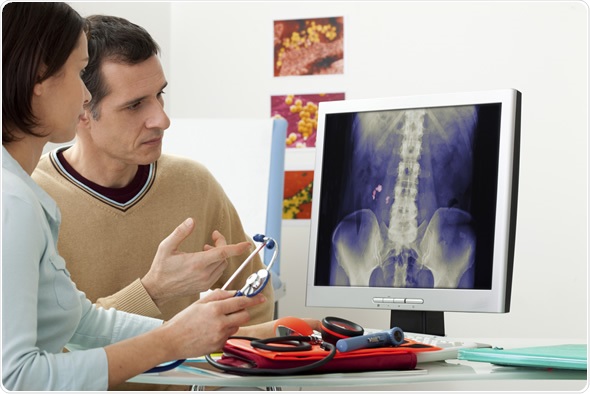Retrograde pyelography is a procedure commonly used by urologists involving X-ray imaging to visualize the kidneys, bladder and ureters. It involves the insertion of a cystoscope into the urinary system and contrast dye administered to the ureters. During this process, X-ray images are used to visualize the movement of the dye and the function of the system.

Image Copyright: Image Point Fr, Image ID: 171515933 via Shutterstock.com
Indications
Retrograde pyelography can be used in several circumstances to investigate the function of the urinary system. This may include to:
- Evaluate ureteral obstruction
- Identify stones or tumors
- Evaluate hematuria
- Aid in placement of a catheter
- Aid in placement of ureteral stent
- Evaluate trauma
Contraindications
There are no absolute contraindications to retrograde pyelography. Unlike intravenous pyelography test, is can also be done in individuals with poor kidney function. However, there are some relative contraindications, when the test should only be used where it is deemed necessary after all risks have been considered. These include:
- Pregnant women: should not receive more than 50mSv of radiation to avoid possible teratogenic effects.
- Infected urine: caution with procedure but benefits of the test (e.g. to aid correct placement of a renal stent) usually outweigh risks.
- Allergy to contrast dye: most patients with allergy do not have an anaphylactic reaction, as the body absorbs only a small amount of the contrast.
Preparation for the Procedure
Before the procedure occurs, there are several things that will need to be carried out. Firstly, patients should have a good understanding of the procedure and what it will involve. It is important that they are able to discuss any questions they have with a health practitioner and they feel comfortable about the proceedings.
It is important that patients are not dehydrated during the procedure, so recommendations to keep fluid intake up should be made. Patients usually need to fast before the procedure, from a few hours before to the night before, depending on the specific case.
During the Procedure
The procedure is usually carried out on an X-ray table, with the patient lying face up and their legs placed in the stirrups. In some cases, an intravenous line may be inserted into their hand or arm to administer a sedative medication or general anesthesia for the procedure.
A thin, narrow tube with a tiny camera at the tip, called a cystoscope, will then be inserted into the urethra and gently pushed up until it reaches the bladder. A catheter may then be inserted into one or both of the ureters.
The contrast dye is then injected into the catheters and renal system and a series of X-ray images are taken to observe the movement of the dye. Following this, the catheter is removed and the remaining dye in the body is observed.
Recovery after the Procedure
Following the procedure, the patient will be taken to the recovery room for a few hours to be monitored for signs of complications or improvement and most patients can go home the same day.
Urination may be painful and there may be a small amount of blood in the urine, which is a normal occurrence shortly after a cystoscopy. If it continues for more than 48 hours, however, patients should seek further medical advice. If needed, simple analgesic medications such as paracetamol or ibuprofen may be recommended to relieve pain.
In some cases, these complications may occur:
- Sepsis (e.g. fever, chills)
- Urinary tract infection (UTI)
- Bladder tear
- Bleeding
- Nausea or vomiting
- Pain or difficulty urinating
Depending on the specific cases, there are suitable management techniques that can be implemented to improve these symptoms and facilitate patient recovery. For example, prophylactic antibiotics may be given to patients following the procedure to prevent a UTI from occurring. Most patients that undergo retrograde pyelography recover well with few complications.
References
Further Reading